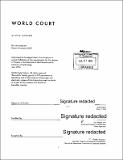World Court
Author(s)
Coburn, Kyle (Kyle Elliott)
DownloadFull printable version (21.25Mb)
Other Contributors
Massachusetts Institute of Technology. Department of Architecture.
Advisor
Ana Miljački.
Terms of use
Metadata
Show full item recordAbstract
Eighteen billion gallons of toxic waste, nine billion dollars in damages, trials across five countries, hundreds of lawyers, millions of dollars in litigation fees, and a corporation with an annual revenue of two hundred billions dollars-this is the story of Texaco's drilling operations in the Lago Agrio region of Northern Ecuador, referred to by locals as "rain-forest Chernobyl". This thesis proposes that the Lago Agrio case, and others like it highlight not only environmental issues, but issues that fall under a much larger umbrella of International Law. With its current cases myopically focused on crimes of African warlords, the International Criminal Court, seated in The Hague, has a latent capacity to work in a new set of crimes of international concern. There is a wide scope of environmental, technological, political and economic phenomena that are not yet part of our definition of International Law. To consider these issues as such, is to drastically rethink the institution of International Law itself, and with it, this thesis argues, the role of architecture in this new form of (highly contentious) universality. Events such as: crimes against nature or shared natural resources, crimes against labor, crimes pertaining to uncoordinated attempts at geoengineering, the development of harmful synthetic biology and nanotechnology, would not only implicate Western and developed, but also corporations, special interest groups and individuals. The thesis is literally cited in the contemporary configuration of the International Court and its Hague reality but it is conceptually cited with a few towards this potentially changing landscape of international law. These crimes, ones that we are all victim to, as well as implicated in, codify the new Global Collective centered around the activities of the Court, there is a multiplicity of vested interests, and one of the key disciplinary questions the thesis addresses is the form of monumentality that this architecture could take given both the multiplicity and scale of those interest-in a climate in which neither the Western and developed countries have the moral upper-hand nor the survival of the planet seems a given.
Description
Thesis: M. Arch., Massachusetts Institute of Technology, Department of Architecture, 2014. Cataloged from PDF version of thesis. Includes bibliographical references (page 99).
Date issued
2014Department
Massachusetts Institute of Technology. Department of ArchitecturePublisher
Massachusetts Institute of Technology
Keywords
Architecture.